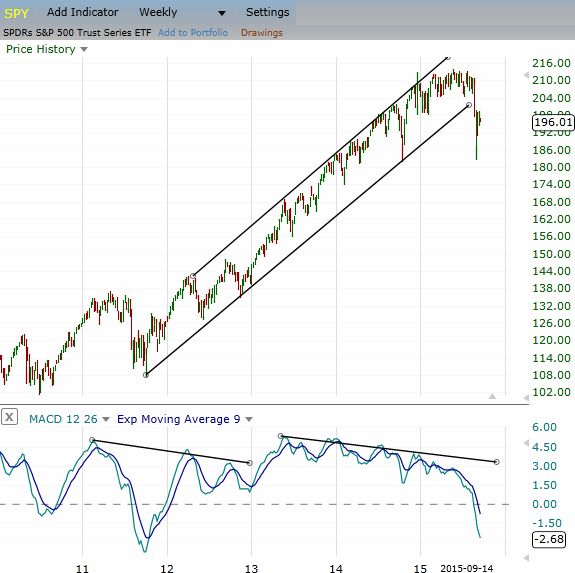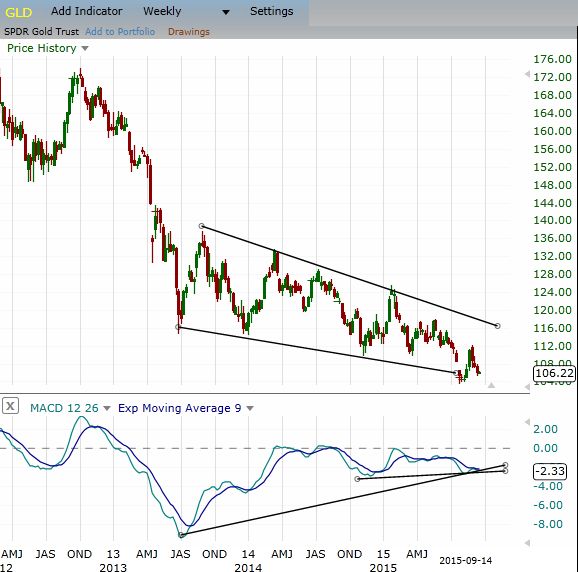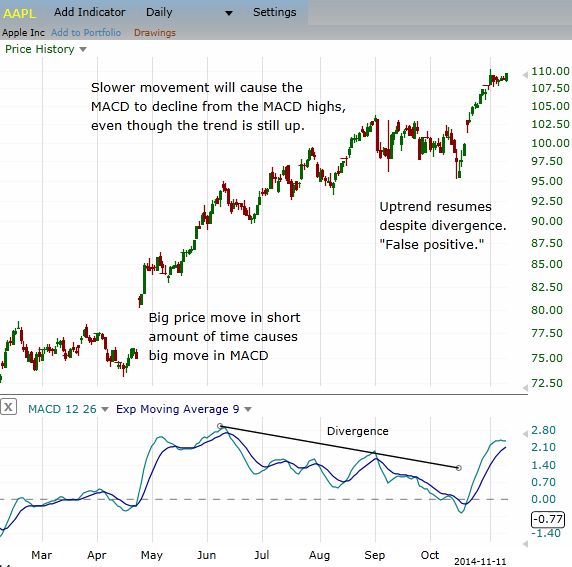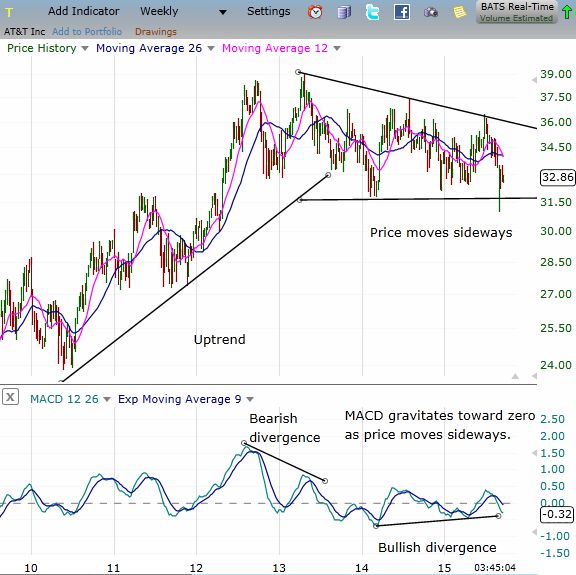MACD divergence is discussed in most trading books and frequently cited as the reason for trend reversals, or as to why a trend could reverse. In hindsight divergence looks great; many examples can be found where a reversal was preceded by MACD divergence. Look closely though, and you'll find that many reverses aren't preceded by divergence, and often divergence doesn't result in a reversal at all. So before assuming divergence is a reliable tool to use in your trading, let's dig deeper into what MACD divergence is, what causes it, and how to improve the use of divergence.
What is Indicator Divergence?
Indicator divergence is when an oscillator or momentum indicator, such as the Moving Average Convergence Divergence (MACD) indicator, doesn't confirm the movement of price. For example, a stock price makes a new high while the MACD or RSI indictor makes a lower high.
SPDR S&P 500 ETF (SPY) Weekly Chart Showing MACD Divergence During Uptrend

Fig 1
Figure 1 shows an example of divergence during an uptrend. The price continues to trend higher, but the MACD on several occasions does not make new highs, and instead creates lower highs.
Indicator divergence is meant to show that momentum is waning during a trend, and therefore more susceptible to a reversal. Divergence is not good at timing when a reversal will occur though, as figure 1 shows. As early as 2012, divergence was present on the chart, even though the uptrend continued into 2015, with significant pullbacks in late 2014 and 2015. This is bearish divergence, when the indicator is making lower highs while the price is making higher swing highs.
Bullish divergence occurs when the price is making lower swing lows while the indicator is making higher lows. It is meant to show that selling momentum is slowing and the downtrend is more susceptible to a reversal. Figure 2 shows bullish divergence; the lows in MACD are rising while the price continues to fall. Despite the presence of divergence between mid 2013 and late 2015, the price continued its downtrend.
SPDR Gold Trust (GLD) Weekly Chart Showing MACD Divergence During Downtrend

Fig 2
Common Problems with MACD Divergence
The two main problems with divergence is that it often signals a (possible) reversal but no actual reversal occurs - a false positive. The other problem is that divergence doesn't forecast all reversals. In other words, it predicts too many reversals which don't occur, and not enough real price reversals.
We'll cover how to handle these problems in the next section. First, here are two common causes of false positives - divergence that almost always occurs in certain situations, but won't necessarily lead to a reversal.
Divergence will always occur when there's a sharp (big movement in a short amount of time) move followed by less sharp movement. This is actually what divergence is meant to capture, as many traders believe that if price movement slows down it's poised for a reversal.
Figure 3 shows a stock gapping higher and then accelerating to the upside. This rapid and large price move causes the MACD to jump, and since the price can't continue to keep gapping higher, divergence occurs. The divergence in this case doesn't indicate a reversal, just that the price movement is slower than the price movement (gap higher) that caused the indicator to jump. The gap caused an unusual jump in the indicator, so as the price returns to more "normal" behavior, divergence occurs. Each price wave of a trend is different, and not all price waves will move rapidly in a very short amount of time. In this case, the jump in price was followed by a slower price rise, resulting in a declining MACD reading, but not a reversal.
Apple Inc. (AAPL) Daily Chart Showing "False Positive" Divergence

Fig 3
After a sharp price move the price movement that follows will almost always be slower (covering less distance or covering it in a shorter amount of time), even though the trend may still be in effect.
"False positive" divergence also often occurs when the price moves sideways, such as in a range or triangle pattern following a trend. As discussed prior, a slow down (sideways movement or slow trending movement) in the price will cause the MACD to pull away from its prior extremes, and gravitate toward the zero line.
The MACD gravitates toward the zero line when the price is moving sideways because the distance between the 26-period moving average and the 12-period moving average - what the MACD is measuring - narrows. The moving averages (shown in figure 4) have a much harder time moving away from each other when the price is moving sideways. Signals that the MACD may provide while this is occurring are degraded, because moving averages - (what the indicator is based on) - do not function well in choppy or sideways markets (moving averages tend to work better in trends).
AT& T Inc. (T) Weekly Chart Showing MACD Moving Toward Zero During Sideways Price Movement

Fig 4
Since the MACD will almost always gravitate toward zero, and likely away from prior extreme MACD highs or lows, when the price moves sideways the MACD will almost always show divergence. Unusually these signals will be of little use because the MACD is just fluttering around the zero line as the moving averages whip back and forth.
Having discussed some of the potential problems with the MACD, and what to watch for, here are some ways to improve on MACD divergence using price action analysis as well.
Always Utilize Price Action with Divergence
Price is the ultimate indicator, with momentum indicators simply manipulating price data. Use price action to aid decision-making when using the MACD. Here are some basic guidelines for doing so:
Even with these guidelines, divergence may provide beneficial insight on some trades, but not others. It's a tool that may aid trading but is not perfect. Understanding the weaknesses, and helping to compensate by also analyzing price action, is required.
In Summary
Using indicators and/or divergence isn't a bad thing. Divergence shows the price is losing momentum relative to prior price swings, but that doesn't necessarily indicate a price reversal. Divergence also doesn't need to be present for the trend to reverse. Divergence almost always occurs when the price makes a sharp move in the trending direction and then moves sideways or continues to trend but at a slower pace. A sharp move followed by a consolidation is often a sign of trend strength, not a reversal as MACD divergence would suggest.
When using divergence, understand what causes it, so that you can avoid some of the problems with indicator divergence. Analyze price action as well; slowdowns in a trend are visible without the use of the indicator, as are price reversals. If using divergence, test its validity for aiding your entry and exit points over a several-month period to assess whether divergence improves your performance or not.
Cory Mitchell can be contacted at Vantage Point Trading
What is Indicator Divergence?
Indicator divergence is when an oscillator or momentum indicator, such as the Moving Average Convergence Divergence (MACD) indicator, doesn't confirm the movement of price. For example, a stock price makes a new high while the MACD or RSI indictor makes a lower high.
SPDR S&P 500 ETF (SPY) Weekly Chart Showing MACD Divergence During Uptrend

Fig 1
Figure 1 shows an example of divergence during an uptrend. The price continues to trend higher, but the MACD on several occasions does not make new highs, and instead creates lower highs.
Indicator divergence is meant to show that momentum is waning during a trend, and therefore more susceptible to a reversal. Divergence is not good at timing when a reversal will occur though, as figure 1 shows. As early as 2012, divergence was present on the chart, even though the uptrend continued into 2015, with significant pullbacks in late 2014 and 2015. This is bearish divergence, when the indicator is making lower highs while the price is making higher swing highs.
Bullish divergence occurs when the price is making lower swing lows while the indicator is making higher lows. It is meant to show that selling momentum is slowing and the downtrend is more susceptible to a reversal. Figure 2 shows bullish divergence; the lows in MACD are rising while the price continues to fall. Despite the presence of divergence between mid 2013 and late 2015, the price continued its downtrend.
SPDR Gold Trust (GLD) Weekly Chart Showing MACD Divergence During Downtrend

Fig 2
Common Problems with MACD Divergence
The two main problems with divergence is that it often signals a (possible) reversal but no actual reversal occurs - a false positive. The other problem is that divergence doesn't forecast all reversals. In other words, it predicts too many reversals which don't occur, and not enough real price reversals.
We'll cover how to handle these problems in the next section. First, here are two common causes of false positives - divergence that almost always occurs in certain situations, but won't necessarily lead to a reversal.
Divergence will always occur when there's a sharp (big movement in a short amount of time) move followed by less sharp movement. This is actually what divergence is meant to capture, as many traders believe that if price movement slows down it's poised for a reversal.
Figure 3 shows a stock gapping higher and then accelerating to the upside. This rapid and large price move causes the MACD to jump, and since the price can't continue to keep gapping higher, divergence occurs. The divergence in this case doesn't indicate a reversal, just that the price movement is slower than the price movement (gap higher) that caused the indicator to jump. The gap caused an unusual jump in the indicator, so as the price returns to more "normal" behavior, divergence occurs. Each price wave of a trend is different, and not all price waves will move rapidly in a very short amount of time. In this case, the jump in price was followed by a slower price rise, resulting in a declining MACD reading, but not a reversal.
Apple Inc. (AAPL) Daily Chart Showing "False Positive" Divergence

Fig 3
After a sharp price move the price movement that follows will almost always be slower (covering less distance or covering it in a shorter amount of time), even though the trend may still be in effect.
"False positive" divergence also often occurs when the price moves sideways, such as in a range or triangle pattern following a trend. As discussed prior, a slow down (sideways movement or slow trending movement) in the price will cause the MACD to pull away from its prior extremes, and gravitate toward the zero line.
The MACD gravitates toward the zero line when the price is moving sideways because the distance between the 26-period moving average and the 12-period moving average - what the MACD is measuring - narrows. The moving averages (shown in figure 4) have a much harder time moving away from each other when the price is moving sideways. Signals that the MACD may provide while this is occurring are degraded, because moving averages - (what the indicator is based on) - do not function well in choppy or sideways markets (moving averages tend to work better in trends).
AT& T Inc. (T) Weekly Chart Showing MACD Moving Toward Zero During Sideways Price Movement

Fig 4
Since the MACD will almost always gravitate toward zero, and likely away from prior extreme MACD highs or lows, when the price moves sideways the MACD will almost always show divergence. Unusually these signals will be of little use because the MACD is just fluttering around the zero line as the moving averages whip back and forth.
Having discussed some of the potential problems with the MACD, and what to watch for, here are some ways to improve on MACD divergence using price action analysis as well.
Always Utilize Price Action with Divergence
Price is the ultimate indicator, with momentum indicators simply manipulating price data. Use price action to aid decision-making when using the MACD. Here are some basic guidelines for doing so:
- Expect to see divergence on the MACD when the price movement slows (relative to prior price waves) or moves sideways. This isn't necessarily an indication of a reversal.
- If divergence is present, don't exit a current trade only because of the divergence. For example, if a stock is in an uptrend, don't exit the long trade simply because divergence is present. As shown, divergence isn't a good timing indicator and may not result in a reversal at all.
- If looking to enter a trade based on divergence, wait for the price to break the current trend, confirming the divergence, before acting. For example, if the trend is up but there is bearish divergence, only go short once the price has broken out of the uptrend and is moving in a downtrend. In an uptrend the price must make lower swing highs and lower swing lows to indicate a new downtrend. For a downtrend to reverse, the price must make higher swing highs and higher swing lows.
- Trust price action more than divergence. If the price breaks out of a prior trend, heed the warning even if divergence wasn't present at the time of the reversal.
Even with these guidelines, divergence may provide beneficial insight on some trades, but not others. It's a tool that may aid trading but is not perfect. Understanding the weaknesses, and helping to compensate by also analyzing price action, is required.
In Summary
Using indicators and/or divergence isn't a bad thing. Divergence shows the price is losing momentum relative to prior price swings, but that doesn't necessarily indicate a price reversal. Divergence also doesn't need to be present for the trend to reverse. Divergence almost always occurs when the price makes a sharp move in the trending direction and then moves sideways or continues to trend but at a slower pace. A sharp move followed by a consolidation is often a sign of trend strength, not a reversal as MACD divergence would suggest.
When using divergence, understand what causes it, so that you can avoid some of the problems with indicator divergence. Analyze price action as well; slowdowns in a trend are visible without the use of the indicator, as are price reversals. If using divergence, test its validity for aiding your entry and exit points over a several-month period to assess whether divergence improves your performance or not.
Cory Mitchell can be contacted at Vantage Point Trading
Last edited by a moderator:
